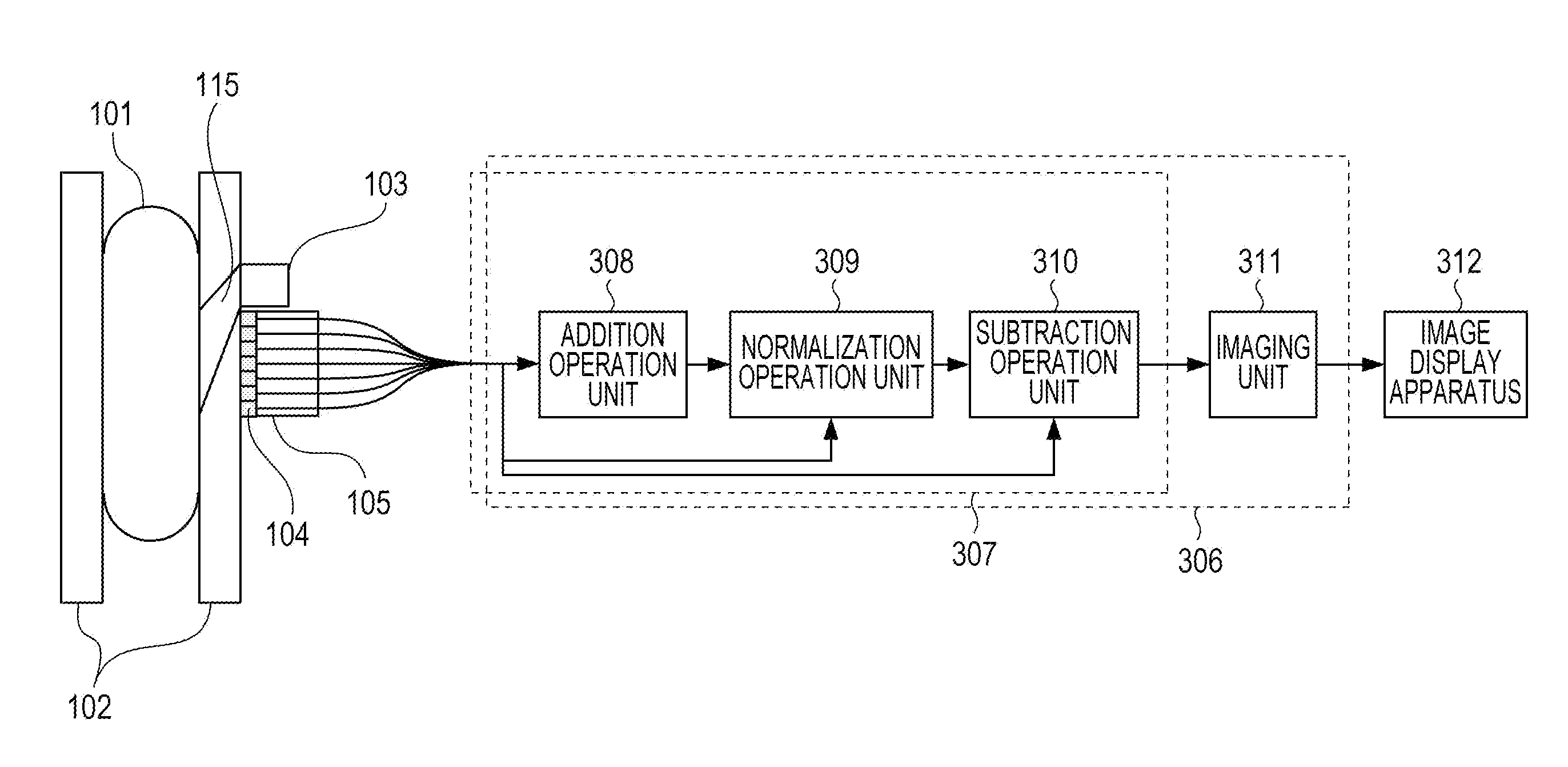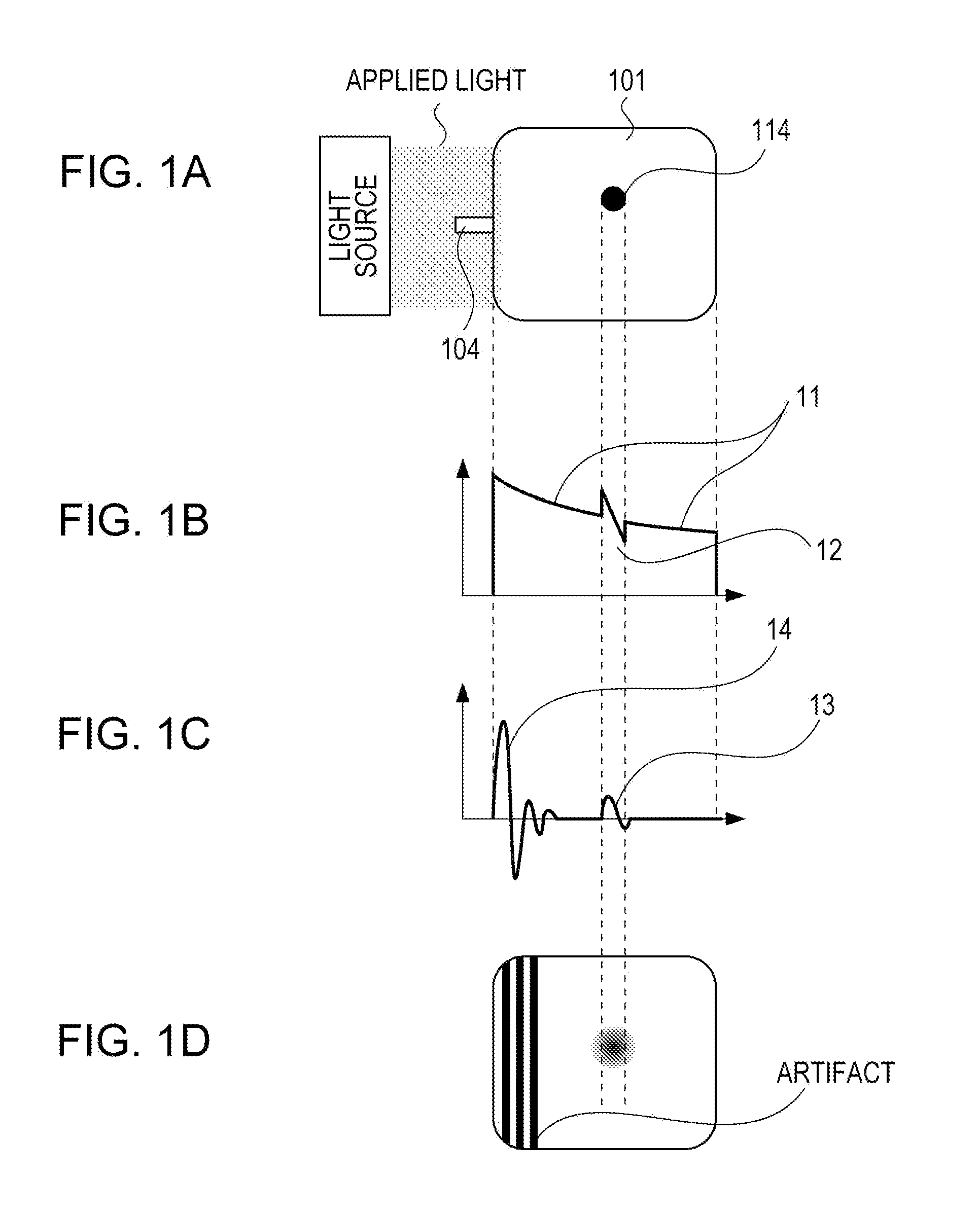Apparatus and method for photoacoustic imaging
a technology of photoacoustic imaging and apparatus, applied in the field of apparatus and method for photoacoustic imaging, can solve the problems of difficult to achieve satisfactory effects, insufficient reduction of amplitude caused by multiple echoes in some cases, and hidden images of light absorbers, so as to reduce artifacts in images
- Summary
- Abstract
- Description
- Claims
- Application Information
AI Technical Summary
Benefits of technology
Problems solved by technology
Method used
Image
Examples
first embodiment
[0031]According to a first embodiment of the present invention, received signals output from acoustic wave detecting devices arranged in an array are added to obtain a summed signal and the summed signal is normalized for each acoustic wave detecting device. The normalized signals and the received signals are used to reduce signal amplitudes caused by an interfacial acoustic wave and a reflected interfacial acoustic wave.
Configuration of Apparatus
[0032]FIG. 3 schematically illustrates a photoacoustic imaging apparatus according to the first embodiment of the present invention. In the photoacoustic imaging apparatus, a light source emits light (pulsed light) and the specimen 101 is irradiated with the light, indicated at 115, through an irradiating unit 103. A light absorber (e.g., tumor to be detected) in the specimen 101 absorbs light energy, thus generating an acoustic wave. The generated acoustic wave is propagated through the specimen and then reaches the acoustic wave detecting...
example 1
[0051]An example in which image data was actually generated according to an application of the first embodiment will be described below. FIG. 6 schematically illustrates a photoacoustic imaging apparatus used. A Nd:YAG laser generating pulsed light of approximately 10 nanoseconds (FWHM) and having a wavelength of 1064 nm was used as a light source. Plastic plates having a thickness of 10 mm were used as holding plates 602. A device array 603 included devices of lead zirconate titanate (PZT) arranged two-dimensionally. The number of devices was 18×18, the arrangement of devices was a square type (square matrix), and the pitch of devices was 2 mm. A signal processor 604 included an interfacial acoustic wave reducer 605 and an imaging unit 606 and was installed as a program on a computer. Signal flows in the signal processor 604 included a flow A and a flow B. In the flow A, received signals were supplied from the device array 603 to the interfacial acoustic wave reducer 605 and reduce...
second embodiment
[0056]A photoacoustic imaging apparatus according to a second embodiment further includes a scanning unit that scans acoustic wave detecting devices and a light-irradiated area (irradiating unit) relative to a specimen. In an adding step, received signals obtained by the same acoustic wave detecting device in different scan positions are added to obtain a summed signal for each acoustic wave detecting device. In a normalizing step, the summed signal is normalized for each scan position and for each acoustic wave detecting device to obtain a normalized signal. In a reducing step, a reduced signal for each acoustic wave detecting device in each scan position is obtained using the received signal and the normalized signal. Such processes can effectively reduce an amplitude caused by an interfacial acoustic wave and that caused by a reflected interfacial acoustic wave even when the spatial distribution of light intensity has a large difference in intensity.
[0057]The second embodiment wi...
PUM
 Login to View More
Login to View More Abstract
Description
Claims
Application Information
 Login to View More
Login to View More - R&D
- Intellectual Property
- Life Sciences
- Materials
- Tech Scout
- Unparalleled Data Quality
- Higher Quality Content
- 60% Fewer Hallucinations
Browse by: Latest US Patents, China's latest patents, Technical Efficacy Thesaurus, Application Domain, Technology Topic, Popular Technical Reports.
© 2025 PatSnap. All rights reserved.Legal|Privacy policy|Modern Slavery Act Transparency Statement|Sitemap|About US| Contact US: help@patsnap.com



